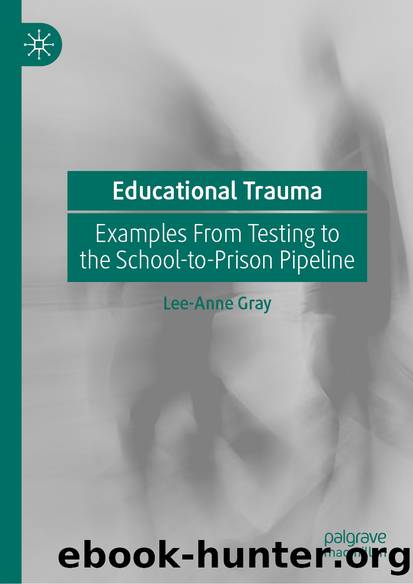Educational Trauma by Lee-Anne Gray

Author:Lee-Anne Gray
Language: eng
Format: epub
ISBN: 9783030280833
Publisher: Springer International Publishing
Larry P. and Brown v. Board of Education represent legal cases that substantiate racist and eugenics practices in education.2 They are legal-historical events and yet relevant and ongoing today. Jonathon Kozol (2012) demonstrated that the Matthew Effect in reading is plaguing low-income communities that are predominantly African American and Latino. Essentially, special and gifted education are pathways for perpetuating segregation of Black and Brown students, and as we will soon see—it worsens sharply with ADHD diagnoses (Chapter 17) and the school-to-prison pipeline (Chapter 18). Disproportionate placement of minority students in special education programs, that follow from mental health diagnoses, and are sometimes associated with medication, lead many marginalized students to the STPP. The interplay and interconnection of schools/education—medicine—law enforcement—criminal justice—prisons—mental health all serve to reify the presence of white supremacy in and through educational systems.
Terman believed that curtailing the reproduction of feebleminded people could lead to an elimination of crime, poverty, and industrial inefficiencies (Kaufman, 2013). It is necessary to point out that at this moment in time, the same ideology is espoused by the current US administration, instead of sterilization, the practice is family separation and detaining children in warehouses and converted retail stores. Parents are being detained and losing their children for seeking asylum. The federal resistance to and rejection of immigrants to the United States resembles the very same ideology Terman espoused in the early 1900s. Essentially, American Nationalism, as signified by Trump’s “Make America Great Again” eugenics practices are returning to the national dialogue. This is how white supremacy thrived in the past, and has reawakened now.
This plays out in modern America in the form of risk identification. Students are tested in schools with one goal being to identify those at-risk. There is a belief that early identification combined with support and extra resources will reduce the level of problems a person faces and crime they contribute to the community. On the most severe end, Rios (2011) describes the policing efforts schools have acquired in service of keeping at-risk students at a low level in schools. Schools, in addition to other connected institutions/systems are policing students, that is, dealing with problem students as if they are potential criminals. Being identified as at-risk in some communities can lead to criminal justice involvement. Rios (2011) described young people who were identified as at-risk were referred directly to the police even before any crimes had been committed. This is the same practice that happened on November 9–10, 1938 in Nazi Germany; Kristallnacht—The night of broken glass. Kistallnacht is marked by violence, destruction, rampage, and the arrest and shipment of men to concentration camps. Coincidentally, on June 18, 2019, President Trump announced that Immigration and Customs Enforcement (ICE) would be rounding up illegal and undocumented immigrants.
“At-risk,” then, is a term that has been euphemistically sanitized to segregate students who may/may not commit a crime before anything even happens at all.
Rather than providing support and extra resources identified above, at-risk students find themselves hypercriminalized. The extra resources are devoted to shaming,
Download
This site does not store any files on its server. We only index and link to content provided by other sites. Please contact the content providers to delete copyright contents if any and email us, we'll remove relevant links or contents immediately.
| Administration | Assessment |
| Educational Psychology | Experimental Methods |
| History | Language Experience Approach |
| Philosophy & Social Aspects | Reform & Policy |
| Research |
The Art of Coaching Workbook by Elena Aguilar(48060)
Trainspotting by Irvine Welsh(20054)
Twilight of the Idols With the Antichrist and Ecce Homo by Friedrich Nietzsche(17705)
Fangirl by Rainbow Rowell(7832)
Periodization Training for Sports by Tudor Bompa(7327)
Change Your Questions, Change Your Life by Marilee Adams(6640)
This Is How You Lose Her by Junot Diaz(5768)
Grit by Angela Duckworth(4735)
Red Sparrow by Jason Matthews(4663)
Asking the Right Questions: A Guide to Critical Thinking by M. Neil Browne & Stuart M. Keeley(4574)
Paper Towns by Green John(4169)
Room 212 by Kate Stewart(4105)
Ken Follett - World without end by Ken Follett(3972)
The Sports Rules Book by Human Kinetics(3588)
Housekeeping by Marilynne Robinson(3401)
The Motorcycle Diaries by Ernesto Che Guevara(3332)
Introduction to Kinesiology by Shirl J. Hoffman(3299)
Exercise Technique Manual for Resistance Training by National Strength & Conditioning Association(3291)
Double Down (Diary of a Wimpy Kid Book 11) by Jeff Kinney(3272)
